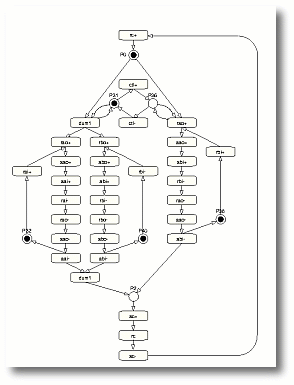Visual STG Lab |
| Open Source Editor |
Home
References
Screenshots
Software
Download
Install
Developer page
Documentation
Manual
Tutorials
FAQ
Latex
Who are we
Authors
Integration with LaTeX
When the STG has reached its final state and fulfill its specifications, the designer typically would like to document the work for others to study. For universities LaTeX is usually the preferred word processor. Like previously stated, the concept of a logical visualization is considered to be crucial not only for one self, but also for other people who might have interest in your work.Creating EPS figures
EPS figures are well suited for inclusion in LaTeX documents. In VSTGL versions beyond 0.3 (not included) this is a fully automated process.From the File menu select Write EPS and you can save an EPS file of the STG.

Figure 1: Screen shot of VSTGL version 0.2. |
 |
Refining EPS figures with Xfig
Figure 2 shows how the end result can appear, when also editing in Xfig is applied. VSTGL can only link with straight arrows connecting two components. This is not always enough. Sometimes we would like some of the arrows to bent, such that the visualization satisfies certain artistically needs just as it is shown on figure 2.Xfig we can modify an EPS figure, if we use the program pstoedit. The source code is available from http://www.pstoedit.net.
The program reads an EPS and produces a *.fig file. Here is what to do:
pstoedit -f fig inputFile.eps outputFile.fig
Open the created .fig file and do your modifications. From XFig you should export the drawing as EPS for further use in e.g. LaTeX.